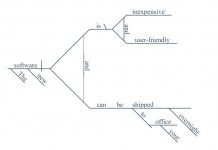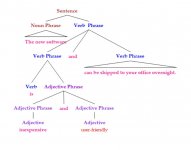Phaedrus
Banned
- Joined
- Jul 19, 2012
- Member Type
- English Teacher
- Native Language
- English
- Home Country
- United States
- Current Location
- United States
Parallelism: "The new software is inexpensive and user friendly, and can be . . ."
Greetings,
I'm experimenting with using Reed-Kellogg diagrams to exhibit multi-level grammatical parallelism for ESL learners. I'd really like to know whether what I have drawn below is accurate in that diagramming system. If TheParser or anyone else who knows and likes the Reed-Kellogg system could tell me, I'd greatly appreciate it.

Sentence Diagrammed: "The new software is inexpensive and user-friendly, and can be shipped to your office overnight."
Thank you!
Phaedrus
P.S. The sentence comes from The Writer's Digest Grammar Desk Reference, by Gary Lutz and Diane Stevenson (2005). It is the correction they offer for one of their nonparallel examples: "[strike]The new software is inexpensive, user-friendly, and can be shipped to your office overnight.[/strike]"
Greetings,
I'm experimenting with using Reed-Kellogg diagrams to exhibit multi-level grammatical parallelism for ESL learners. I'd really like to know whether what I have drawn below is accurate in that diagramming system. If TheParser or anyone else who knows and likes the Reed-Kellogg system could tell me, I'd greatly appreciate it.

Sentence Diagrammed: "The new software is inexpensive and user-friendly, and can be shipped to your office overnight."
Thank you!
Phaedrus
P.S. The sentence comes from The Writer's Digest Grammar Desk Reference, by Gary Lutz and Diane Stevenson (2005). It is the correction they offer for one of their nonparallel examples: "[strike]The new software is inexpensive, user-friendly, and can be shipped to your office overnight.[/strike]"
